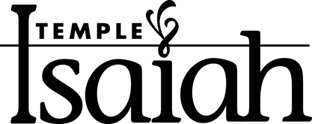Customs

Welcome! Temple Isaiah is an inclusive community welcoming people of all ages, backgrounds and abilities into our midst. Jewish history has spread our people throughout the world. As a result, Jews vary in our appearance, philosophy and ritual practice. Temple Isaiah includes a high percentage of interfaith families who find a warm home here. We hope that the descriptions of our ever-evolving customs, below, will help you feel comfortable and very welcome to join us for worship.
- Greeters
Members of the Temple Isaiah Board of Directors greet people at the entrance to our sanctuary with a warm “Shabbat Shalom.” On Friday nights, our greeters hand out a weekly Shabbat Announcements flyer. Our greeters will be happy to answer questions and offer any assistance you may need.
- Sacred Time and Space
As we enter the sanctuary, we also enter into a sacred space and a holy time. Please add your voice and strength to the community by joining in the poetic readings and prayers in song. If you are not a Hebrew reader, use the transliterations in our prayerbook. And, in the spirit of creating and sustaining sacred time, we ask you to power down your devices to help allow your soul to fill with Shabbat peace. During services, our worshippers turn off their cell phones and refrain from taking pictures.
- All Abilities Welcome
Being an inclusive community means we welcome people of all ages and abilities to worship with us. Our community includes and warmly supports adults and children with special needs, some of whom make noise or move around more or less than others. We want everyone to feel comfortable. Assisted listening devices are available from the greeters. While there are times during our services when the congregation stands, we recognize that there are those among us who are unable. In addition, if a loved one needs a break, or you need to lie down, a break room is available. Located just down the hall from the sanctuary, the room has a sofa, restroom, and audio feed from the sanctuary, making it possible to follow the service.
- Sacred Books
In the pews of our sanctuary, you will find two blue books. The smaller of the two books is Mishkan T’filah, a Reform Siddur (prayer book). It is used for Shabbat services and contains both English and Hebrew. As you can see, a prayer is typically spread over two pages. The Hebrew is written in both Hebrew letters and transliterated English (1). A traditional translation is offered on the right hand side (2). Alternative translations and interpretations of the prayer are offered on the left-hand side (3). Additional citations and explanations appear at the bottom of the pages (4).
The larger book in the pews contains the Torah, in both English and Hebrew. It is used primarily during Shabbat morning services.
- Kippot and Tallitot
Wearing head coverings, called kippot or yarmulkes, during services is a sign of respect that reminds us that in a spiritual sense, God is ‘above’ us. While it is traditional that men wear kippot, at Temple Isaiah all people are welcome and encouraged to wear them.
Jews over the age of bar/bat mitzvah are welcome to wear tallitot (prayer shawls) when attending morning services. Tallitot have tzitzit (fringes) that are reminders of the mitzvot (commandments). During the recitation of the Sh’ma, the tzitzit on the four corners of the tallit are gathered together and held over the eyes as we create a unity to parallel God’s Oneness.
Communal kippot and tallitot are available from the rack in the lobby outside the sanctuary for those who do not bring their own.

- Clergy
Temple Isaiah has a diverse and dynamic clergy team. Which individual clergy members typically lead the congregation varies by type of service. Learn more at https://temple-isaiah.org/about/staff-and-clergy/

